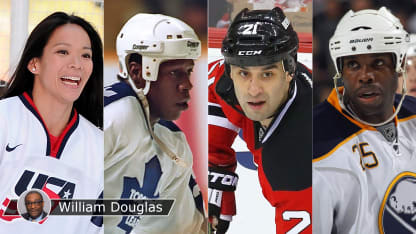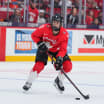William Douglas has been writing The Color of Hockey blog for the past seven years. Douglas joined NHL.com in March and will be writing about people of color in the game. Today, he looks at four candidates of color who could be considered for election into the U.S. Hockey Hall of Fame.
Color of Hockey: Gomez could follow Henderson into U.S. Hall of Fame
Grier, Chu, James also among potential candidates to join first elected black honoree

Neal Henderson, the coach and founder of the Fort Dupont Ice Hockey Club, was elected to the U.S. Hockey Hall of Fame on Sept. 4. He will become its first black inductee and its third person of color at a ceremony in Washington on Dec. 12, joining retired forward Henry Boucha and longtime NHL player Bill Guerin, now general manager of the Minnesota Wild.
The selection committee cited Henderson for creating the North America's oldest minority-oriented youth hockey program, which has helped produce a generation of minority players and fans in Washington and beyond.
"For over 40 years, as a volunteer, he provided hockey to underserved and marginalized children and their families through an organization that has always used the game to build character and teach positive life skills," Dave Fischer, a USA Hockey spokesman, said Wednesday in announcing Henderson's election. "He is truly a selfless man. He has led the way in our country and has inspired the creation of other like programs in Harlem, Philadelphia, Boston and beyond."
What other candidates of color could follow Henderson, increase the U.S. Hall's diversity and fulfill its induction criteria that nominees exhibit extraordinary contribution to hockey in the United States? Here are some suggestions:
Scott Gomez
Gomez had 756 points (181 goals, 575 assists) in 1,079 NHL games for the New Jersey Devils, New York Rangers, Montreal Canadiens, San Jose Sharks, Florida Panthers, St. Louis Blues and Ottawa Senators. He had 101 points (29 goals, 72 assists) in 149 Stanley Cup Playoffs games and was a member of the Devils' championship teams in 2000 and 2003. Gomez also won the Calder Trophy as the NHL's best rookie in 1999-2000.
The son of a Mexican-American father and Colombian mother, Gomez played for the United States at the 2006 Torino Olympics, at the IIHF World Junior Championship in 1998 and 1999 and the World Cup in 2004.
Gomez, who spent the past two seasons as an assistant with New York Islanders, has contributed time and money to help keep youth hockey alive in his native Alaska, particularly girls high school hockey, through his Scotty Gomez Foundation.
Mike Grier
Grier had 383 points (162 goals, 221 assists) in 1,060 NHL games for the Edmonton Oilers, Washington Capitals, Buffalo Sabres and San Jose Sharks from 1996-97 to 2010-11. He had 28 points (14 goals, 14 assists) in 101 Stanley Cup Playoff games.
The Detroit native had 120 points (59 goals, 61 assists) in 114 games for Boston University from 1993-94 to 1995-96. He was a member of BU's 1995 NCAA championship team and a finalist for the Hobey Baker Award, presented to men's college hockey's top player, that season.
Grier is in his second season as an assistant with the Devils and is one of the few NHL coaches of color who works behind the bench during games.
Julie Chu
Chu scored 284 points (88 goals, 196 assists) for Harvard University between 2002-03 and 2006-07. She was a four-time All-America selection and the recipient of the Patty Kazmaier Award -- presented annually to the best NCAA Division I women's hockey player -- and the Bob Allen Women's Player of the Year by USA Hockey in 2007.
She's a four-time U.S. Olympian who won three silver medals (2002, 2010, 2014) and one bronze (2006). Chu carried the U.S. flag at the closing ceremony of the 2014 Sochi Olympics, joining Hockey Hall of Famer Cammi Granato as the only women hockey players to have that honor.
The native of Bridgeport, Connecticut, played on U.S. teams that won the IIHF Women's World Championship in 2005, 2008, 2009, 2011 and 2013, and finished second in 2001, 2002, 2007 and 2012.
Professionally, Chu played on three championship teams (2011, 2012, 2017) with Montreal of the Canadian Women's Hockey League. She scored 93 points (18 goals, 75 assists) in 95 CWHL games and was the league's most valuable player in 2009-10.
Chu is the women's hockey coach at Concordia University in Montreal.
Val James
Why enshrine a player who didn't have a point in the NHL and appeared in 11 games for the Sabres and Toronto Maple Leafs from 1981-82 to 1986-87?
Because James was the NHL's first U.S.-born black player. He was born in Ocala, Florida, and raised on Long Island, about an hour away from Madison Square Garden.
He carried the heavy burden of being a "first" or an "only" during a career that saw him play 416 games for Rochester and St. Catharines of the American Hockey League (14 goals, 20 assists), the Eastern Hockey League (15 goals, 31 assists in 139 games) and the International Hockey League (two goals in eight games). James scored the Calder Cup-winning goal for Rochester (under rookie coach Mike Keenan) in 1983.
James regularly endured racist taunts by fans and opposing players. A CBS News "Sunday Morning" crew captured the level of vitriol on film during a game at the Salem-Roanoke County Civic Center in Virginia in 1981 as the crowd loudly chanted racial epithets when James took the ice. One fan brought a watermelon to the game.
Being a trailblazer was painful -- James said he couldn't bear to watch a hockey game for 10 years after he retired in 1988 because of a shoulder injury -- but he wouldn't trade his playing career for anything.
At least 17 U.S.-born black players have followed James' path into the NHL, including Grier, Kyle Okposo, Dustin Byfuglien, Seth Jones, JT Brown and Jordan Greenway. That legacy makes James proud.
"I feel I have opened a few doors for guys that might not have gotten that chance later on in their careers," he wrote in "Black Ice: The Val James Story," his 2015 autobiography. "So to be able to do something like that for someone, whether it be my race or someone else's race, it's just a nice thing to do."

















